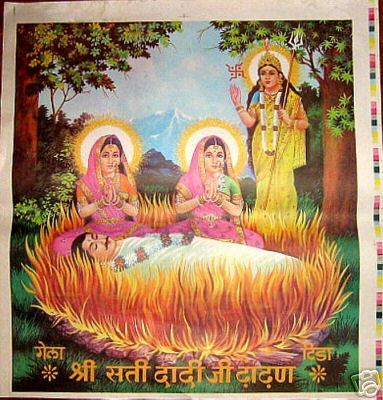Sati is the name given to a disturbing practice of Hindu women being so devoted to their husbands that when the husband died, the widow was so overcome with grief that she would leap onto the funeral pyre and burn herself alive. It seems that after a few cases of this it became, for some, a cultural tradition and there are rumors of women being forced onto their husband’s funeral pyres in historic Hinduism. So is this practice a part of our religion? Is it condoned by our holy stories?
The online magazine Sanskriti Magazine has a wonderful article on this topic and they have explained it so much better than I ever could. Please do read their essay: Sati Partha -Truth and Facts
It starts with a conversation between a Hindu and a Muslim about how some people practice things in the name of their faith that are abhorrent to the vast majority of followers.
It then addresses the scriptural cases that seem to support the idea of sati (Kunti and Madri are mentioned. In that case the reason that Kunti did not die is that someone had to raise the children. Madri asked to kill herself because she felt responsible for her husband’s death even though Kunti points out that it was part of his destiny. And as the article rightly points out, just because a single character in the Mahabharata does this act it does not mean that the Mahabharata supports that act. It’s a complex tale showing both good and bad).
The article finishes with a section on the history of sati and explaining that it was not thanks to the “British saviors” that the practice was abolished.
I think that the original basis of sati is very similar to the story from the Bible known as the Fiery Furnace. When three young men refuse to bow to a different God than the Jewish God they are put into a furnace to be burned alive. The strength of their faith protects them and they leave the fire unscathed. You can see how this is a story that illustrates the power of faith and trust even though it is unlikely that this ever really happened. Sati began as a story illustrating the intense power of overwhelming love. But when people praised that act of love, it became an instruction manual for how everyone should be! It seemed an ideal goal to love that deeply.
Thus the practice took hold in some communities and became solidified into a code.













